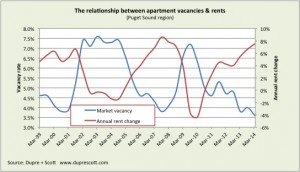Good Ideas for Better Housing Choices: Keep Single-Family Infill
I came away from yesterday’s meeting of the Planning, Land Use, and Sustainability (PLUS) Committee with mixed feelings. On the one hand there was a great presentation by Mike Scott of Dupre and Scott which confirmed a number of things for the Committee, not the least of which is that supply and demand really does apply to the housing market.
But I didn’t get positive signals from Committee staff who said that Councilmember O’Brien is leaning toward the recommendations of DPD on small-lot housing. As I pointed out in my comments to the Committee, we made lots of progress toward the end of last year getting closer to a solution for small-lots that would produce greater predictability for neighbors and developers: the 80 Percent Rule. What was on the table then, was adjusting the percentage to 100 or maybe 90 percent with no minimum lot size.
The 80 Percent Rule would allow everyone, builders and neighbors, to know exactly what was a buildable lot on their block by allowing building with setbacks and height limits on lots 80 percent of the average lot on a block.
Instead the DPD proposal takes away more potential infill opportunities by imposing even more arcane rules. One of the best projects in recent memory at Benchview was touted by DPD staff as something that should be stopped instead of seen as a way to preserve existing housing and build new appropriately scaled housing in a single-family neighborhood.
We’ll keep making the case. Ada Healy, Vice President of Vulcan Real Estate had a great opinion piece in the Daily Journal of Commerce that points out exactly what we’re all hoping the Council will keep in mind in the weeks ahead.
We should also adopt policies that encourage more housing supply, choices and opportunities. According to Smart Growth Seattle, a partnership focused on improving Seattle’s land-use code, “Seattle needs policies that make Seattle accessible to people of all incomes by increasing the choices they have. The best way to create more choices for everyone in the city is to allow more housing of all types all over the city.”
Increasing supply includes supporting micro-housing and accessory dwelling units in locations that make sense, making city-owned land available for low-income and workforce housing development, increasing density around transit areas and implementing other innovative tools that would help balance supply and demand.
The challenge of housing affordability is complex and multifaceted, and incentive zoning alone is not the answer — especially in its current form. Seattle deserves housing and land-use policies that provide opportunities for all income ranges by expanding the programs that are working and embracing a wide range of new and innovative options.
Healy is right when it comes to how we should approach housing challenges as we create more jobs and welcome more people into our city: innovation. But is the City Council listening?
Ask Councilmember O’Brien and the Committee to reconsider the 80 Percent Rule as a way to accomplish scaled infill development of new single-family homes on small-lots. Their e-mails are below.
Councilmember Mike O’Brien, Chair
Councilmember Tim Burgess
Councilmember Nick Licata


